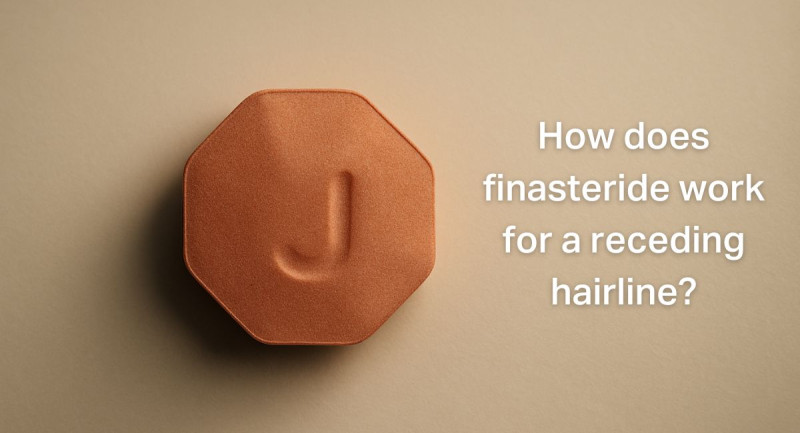How Finasteride Works For A Receding Hairline: A Clear, Science-Backed Guide For Men In Canada


A receding hairline is one of the earliest and most common signs of male pattern hair loss, and many men begin searching for an effective hair loss treatment in Canada long before the thinning becomes visible to others.

Finasteride is one of the most studied options for slowing this process and helping the follicles recover. It works by targeting the hormone that drives genetic hair loss and gives the scalp a better chance to maintain and rebuild healthier hair over time.
In this guide, we explain how finasteride works, what results you can realistically expect, and why early treatment is the key to protecting your hairline.
Topics covered in this article:
What Is Finasteride?
Finasteride is a medication used to treat male pattern hair loss by targeting the hormone that affects genetically sensitive hair follicles. This section explains the types of finasteride available in Canada, how it is approved, and why some men are more affected by DHT than others.

Oral finasteride
The oral form is a once-daily tablet (typically 1 mg for hair loss) that works throughout the body to lower DHT levels. It is the only version approved by Health Canada for treating male pattern hair loss.
Topical finasteride
Topical finasteride is applied directly to the scalp. It is used off-label in Canada and can be prescribed through a compounding pharmacy. It aims to reduce DHT activity on the scalp with lower systemic absorption. It is not Health Canada-approved, but is allowed under physician direction.
Health Canada approved uses
Finasteride 1 mg is approved for male pattern hair loss in men. The 5 mg dose is approved for benign prostatic hyperplasia. These approvals are limited to adults and based on long-term evidence of how finasteride affects DHT.
How DHT contributes to a receding hairline
DHT is a hormone created when testosterone is converted by the enzyme 5-alpha reductase. High levels of DHT shrink hair follicles in men who are genetically sensitive. This process leads to thinning at the temples, loss around the hairline, and gradual miniaturization of the follicles.
Genetics and androgen sensitivity
Some men have hair follicles that react strongly to DHT because of inherited sensitivity. Two men can have the same hormone levels but very different hair loss outcomes. Early treatment helps protect follicles that are still active.
Finasteride works best when men understand how DHT and genetics interact. Knowing this helps set realistic expectations and highlights why finasteride is most effective when started early.
How Finasteride Works: The Mechanism Explained
Understanding how finasteride works can help you set realistic expectations for your hairline and overall hair density. This section breaks down the hormone involved, how finasteride blocks it, and why certain parts of the scalp respond better than others.
Role of the 5 alpha reductase enzyme
This enzyme converts testosterone into dihydrotestosterone, also known as DHT. The Type II form of this enzyme is found in hair follicles and the prostate. When DHT levels remain high around sensitive follicles, the hair gradually becomes thinner and shorter.
How finasteride blocks the conversion of testosterone to DHT
Finasteride attaches to the Type II 5 alpha reductase enzyme and reduces its activity. With less enzyme activity, less testosterone is converted into DHT. Lower DHT levels help protect follicles that are at risk of shrinking.
Impact on scalp follicles that have started to miniaturize
High DHT levels cause miniaturization, which means the follicle shrinks and produces finer hair. When DHT decreases, the follicle can recover and begin producing thicker strands. The process is gradual and requires consistent daily use.
Why finasteride often works better on the crown than the hairline
The crown area has a larger number of follicles that can still recover when DHT is reduced. The hairline is more genetically sensitive and tends to respond more slowly. Some improvement is still possible, but the crown typically shows stronger results.
Clarifying that finasteride does not meaningfully increase testosterone
Although finasteride reduces DHT, testosterone levels usually rise only slightly. The increase is small and not significant enough to be considered a therapeutic effect. The main action is lowering DHT, not boosting testosterone.
Finasteride supports healthier hair growth by reducing the hormone that harms sensitive follicles. When used consistently, it helps create a more stable environment for hair recovery, especially in areas that respond well to lower DHT levels.
Finasteride Results Timeline: What to Expect
Finasteride works gradually, and understanding the typical timeline helps keep expectations realistic. Hair follicles respond slowly to hormonal changes, so consistent daily use is essential for noticeable results. Here is what most men experience during the first year.
Month 1 to 3: less shedding and early stabilization
Some men experience temporary shedding as older, weaker hairs fall out and healthier strands begin to grow. This phase is normal and usually short. By the end of this period, shedding often slows and the scalp starts to stabilize.
Month 3 to 6: reduced thinning and early signs of regrowth
Hair fall continues to decrease, and many men notice that thinning areas look less pronounced. Early regrowth usually appears as soft, fine hairs that gradually become thicker.
Month 6 to 12: stronger improvement and peak results
The most significant changes occur in this window. Thicker hair, better coverage, and improved density become more visible. Many clinical studies show that the twelve month mark is when the maximum benefit is usually reached.
Maintenance phase: results only last with continued use
Finasteride must be taken long term to maintain progress. If treatment is stopped, DHT levels return to normal and the follicles slowly revert to their previous state. Most of the benefits are lost within several months of discontinuation.
Why progress photos help
Changes happen slowly, which makes it difficult to assess improvement with the naked eye. Monthly photos taken in the same lighting and angle help track real progress and show subtle gains that might otherwise go unnoticed.
Finasteride delivers its best results when used consistently and evaluated over many months. Understanding this timeline makes the journey clearer and helps keep expectations realistic.

How Effective Is Finasteride for a Receding Hairline?
Finasteride can slow, stop, or partially reverse hairline thinning, but the level of improvement varies from person to person. This section explains how well the medication works in different areas of the scalp, how many men typically respond, and what expectations make sense for hairline treatment.
Clinical data on hairline vs crown response
Studies show that finasteride works for both the crown and the hairline, but the crown usually responds more noticeably. Research has documented measurable gains in the frontal scalp, although the improvement tends to be milder than in the vertex region.
Percentage of men who maintain vs regrow hair
Many studies report that the majority of men taking finasteride will maintain their current hair (i.e., avoid further loss) and a smaller portion will experience regrowth. One source reports ~85% maintenance and ~65% some degree of regrowth.
For the hairline specifically, a review cited up to ~37% of men achieving mild-to-moderate regrowth in the frontal region.
These numbers set a realistic baseline: maintaining what you still have is more likely than dramatic regrowth of a severely receded hairline.+
What counts as realistic expectations
Finasteride is most effective at preventing further recession. Some men see the hairline become fuller or more defined, but full restoration of a significantly receded hairline is less typical. Men who begin treatment early tend to have the best outcomes.
Realistic expectations mean:
- Stopping further hairline recession is a valid success.
- Some thinning may reverse, especially early on, but full restoration of a mature hairline is less common.
- Younger men with early hairline recession tend to respond better than those with long-standing or advanced loss.
- The hairline is tougher to treat than the crown; setting the goal to preserve and modestly improve is smart.
Why combining finasteride and minoxidil works better
Finasteride reduces DHT, which helps protect follicles from shrinking. Minoxidil encourages hair growth and thickening. When used together, they support the follicles through two different pathways, which often produces better results than either treatment alone.
Finasteride is a reliable option for slowing or improving hairline recession, especially when used early and paired with supportive treatments. It offers the strongest benefits when men understand its strengths and limitations.
Safety and Considerations
Finasteride is generally well-tolerated, but it is important to understand when extra caution is needed. This section highlights common safety considerations, who should avoid the medication, and when to speak with a healthcare provider in Canada.
• When to avoid finasteride
Finasteride may not be recommended for men who are actively trying to conceive, since it can lower sperm count in a small number of users. Most changes are reversible after stopping the medication. Rare side effects can occur, including changes in sexual function or mood. These effects usually improve when treatment is adjusted or discontinued.
• Pregnancy precautions
Finasteride should not be handled by someone who is pregnant or may become pregnant, especially if the tablet is crushed or broken. A whole tablet has a protective coating, but a damaged tablet can allow absorption through the skin. This precaution exists because finasteride can affect the development of a male fetus.
• Oral versus topical absorption
Oral finasteride affects DHT levels throughout the entire body, since it enters the bloodstream after digestion. Topical finasteride is absorbed mainly in the scalp, which may reduce systemic exposure, although some absorption still occurs. Oral finasteride is the only form approved by Health Canada for hair loss.
• When to talk to a healthcare provider
Men who notice side effects, changes in mood, difficulty conceiving, or unexpected symptoms should speak to a licensed healthcare provider. A professional can determine whether dosage adjustments, switching medications, or adding a supportive treatment is appropriate.
• Health Canada guidance
Health Canada approves finasteride for male pattern hair loss at the 1 mg dose and for prostate enlargement at the 5 mg dose. The agency also lists known precautions, potential side effects, and rare risks that patients should review with their prescriber before starting treatment.
Understanding these safety points helps men use finasteride more confidently and make informed decisions about long-term treatment. With proper guidance, most users tolerate the medication well and benefit from consistent use.
Is Finasteride Right for You?
Finasteride can be a strong option for many men, but it works best under specific conditions. This section helps you understand whether you are a good candidate and when treatment is most likely to produce meaningful results.
• Ideal candidates
Men with early to moderate male pattern hair loss tend to benefit the most from finasteride. Those who still have active follicles, even if the hair is thinning, usually see better outcomes than those with large areas of complete loss. Men who prefer a long-term, low-maintenance treatment often find finasteride easy to incorporate into their routine.
• Early intervention compared to late-stage hair loss
Finasteride works by protecting follicles that are still alive, which is why starting early is so important. Early intervention helps preserve the hairline and crown before miniaturization becomes too advanced. Late-stage hair loss, where follicles have already stopped producing hair, responds less effectively.
• Receding hairline patterns where response is strongest
Men with mild to moderate temple recession or early frontal thinning tend to see the most improvement. Finasteride can strengthen weakened hairs in these areas and slow further recession. Severe temple loss or deep V-shaped recession is less responsive because many follicles may already be inactive.
• When switching providers or treatments makes sense
If progress is slow, if side effects appear, or if another treatment may offer better results, switching providers or adjusting your plan can be helpful. A clinician can review your response, recommend combining treatments, or confirm whether your hair loss pattern requires a different approach.
Finasteride is a practical and reliable choice for many men facing early hairline changes, especially when decisions are guided by a knowledgeable healthcare provider. Identifying your stage of hair loss makes it easier to know whether this treatment is likely to work well for you.

Conclusion
Finasteride remains one of the most dependable treatments for slowing a receding hairline and protecting the follicles that are still active. Its strength lies in reducing DHT, the hormone that accelerates thinning in genetically sensitive areas. With consistent use, many men see noticeable stabilization and gradual improvement over time. For the best results, early intervention, realistic expectations, and open communication with a licensed Canadian provider are key.
Frequently Asked Questions
Most men start noticing early changes between three and six months. The full benefit usually appears around the twelve-month mark. Consistency is the most important factor in improving and maintaining hair growth.
Finasteride can improve a thinning hairline, especially in early stages, but complete restoration of a significantly receded hairline is less common. Many men see stronger improvement at the crown compared to the frontal area.
Finasteride is generally considered safe for long-term use when monitored by a licensed healthcare provider. Most men tolerate it well. Any concerns about side effects or fertility can be discussed with a medical professional.
Yes. In Canada, finasteride requires a prescription for both the 1 mg hair loss dose and the 5 mg prostate dose. A licensed provider must review your health history before prescribing it.
Yes. Many men benefit from using both treatments because finasteride protects follicles by lowering DHT, and minoxidil supports growth and density. The combination often produces better results than either treatment on its own.
References
UPGUYS has strict sourcing guidelines to ensure our content is accurate and current. We rely on peer-reviewed studies, academic research institutions, and medical associations. We strive to use primary sources and refrain from using tertiary references.- Finasteride in the treatment of men with frontal male pattern hair loss, PubMed,
https://pubmed.ncbi.nlm.nih.gov/10365924/ - Finasteride (oral route), Mayo Clinic,
https://www.mayoclinic.org/drugs-supplements/finasteride-oral-route/description/drg-20063819 - Finasteride For Hair Loss Regrowth: Does it Work, & at What Dose? Solve Clinics,
https://solveclinics.com/finasteride-for-hair-loss/ - Does Finasteride Work For a Receding Hairline? Wimpole Clinic,
https://wimpoleclinic.com/blog/does-finasteride-work-for-a-receding-hairline/
This article is written for informational purposes only and does not constitute medical advice. The information provided in the articles cannot and should not replace advice from a healthcare professional. Talk to your healthcare provider about any physical or mental health concerns or the risks and benefits of any treatment or medication.





